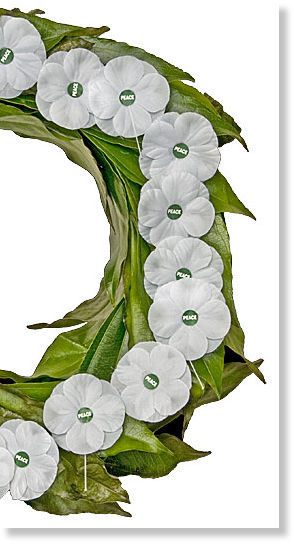
© Peace Pledge Union
So far this year we've been spared the almost annual clash between the custodians of the red Remembrance Day poppy and anti-war activists who promote the white poppy of peace.
Last year, the Royal Canadian Legion threatened to sue peace groups if they tried to sell white poppies, seeing it as an infringement of their rights to the symbol. So far white-poppy advocates have kept a low profile.
It's surprising to learn the feud is almost as old as the lapel poppy itself.
The red poppy was adopted in 1921 as a symbol of remembrance of First World War dead, first in Britain and then Canada and other British Empire combatants.
The unprecedented, senseless slaughter in the trenches also sparked a strong pacifist movement that lobbied the British Legion to print No More War in the centre of the red poppy, according to the UK-based
Peace Pledged Union. Failing to do that, pacifists suggested they should create their own version.
The first white poppies were produced by the Co-operative Women's Guild in 1933. The Peace Pledge Union joined the Guild in distributing white poppies the following year.
"The Guild stressed that the white poppy was not intended as an insult to those who died in the First World War . . . but a challenge to the continuing drive to war," the union says on its web site.
"The
white poppy symbolises the belief that there are better ways to resolve conflicts than killing strangers. Our work, primarily educational, draws attention to many of our social values and habits which make continuing violence a likely outcome."
The British Legion and its Commonwealth counterparts have guarded the poppy symbol jealously in part because it is a major fund-raising vehicle.
Last year, the Canadian Legion threatened to sue peace groups in Prince Edward Island and Ontario if they did not stop handing out white poppies in the run-up to Remembrance Day.
"It's simply a trademark issue," said legion spokesman Bob Butt told
CTV News at the time. "We own the trademark on the poppy."
"It's remembrance season, it's not peace season. If they want to distribute something they can distribute a dove."
Proponents of the white poppy, such as Ottawa activist Brenda Vellino, said at the time that while her father and grandfather were soldiers she was promoting the white poppy to remember the non-military victims of war.
The Peace Pledge Union singled out Canada, New Zealand and Australia for linking the carnage of the First World War with the birth of their national identities.
"It is not surprising that politicians, and to some extent the military, sentimentalise these grim events, which, after all, seem to help to justify war in the minds of some of the public," the group said in a 2006 post.
"But it is desperately sad and problematic that many people, especially non-participants, also find meaning and a sense of their identity in celebrating those disasters."
The Salvation Army noted last year's dispute and wondered who was right.
"White poppy promoters believe all war is wrong and the poppy for them is a symbol of peace, non-violence and remembrance of civilians who have died in the line of fire," it said in a web post last year.
"They believe there are better ways to resolve conflict than to kill strangers. Is wearing a white poppy an act of disrespect? Does the white poppy reflect more accurately what Remembrance Day should be about?"
The Sally Ann seemed to be answering its own question but many commenters appeared to disagree.
"The white poppies co-opt the meaning of the red," Charles R. Kaiser responded. "We can pray for peace and desire it, but the red poppies stand for the blood of men and women lost to war. To wear a white poppy is to discount that sacrifice"
Shelly Mills added this: "I'm not sure if the white poppy is meant to be disrespectful, but it feels that way to me."
We'll see what this year brings.
Reader Comments
to our Newsletter